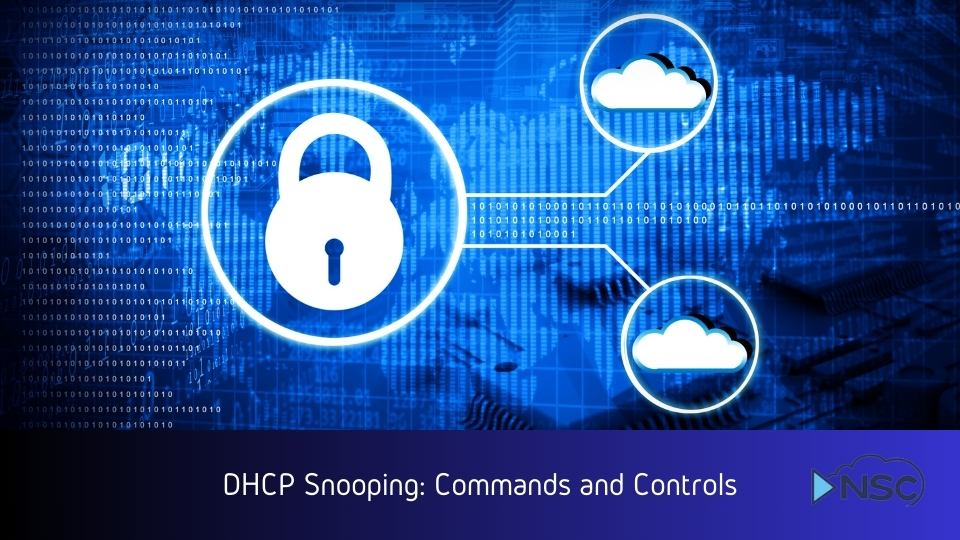In the dynamic landscape of network security, effective management and security of network transactions are essential. DHCP snooping is a robust mechanism designed to enhance the security of a network by monitoring and controlling unwanted DHCP traffic and preventing the activity of unauthorized DHCP servers.
This blogpost provides a thorough exploration of DHCP snooping, highlighting the crucial commands and controls necessary for its effective management.
By mastering these techniques, network administrators can shield their networks from prevalent threats such as spoofing and man-in-the-middle attacks. This guide aims to arm you with knowledge and practical tips to apply DHCP snooping effectively, ensuring a fortified network environment.
For an in-depth look at how DHCP snooping enhances network security by monitoring and controlling DHCP traffic, click here to read our detailed blog post on Understanding DHCP Snooping.
Configuring DHCP Snooping
Proper configuration of DHCP snooping is essential for enhancing the security of your network. This section details the steps and commands necessary to implement DHCP snooping effectively on network switches, particularly focusing on environments using Cisco equipment.
Enabling DHCP Snooping
To begin configuring DHCP snooping, it is crucial to enable it globally across the network and then specify the VLANs where it should be active.
- Global Configuration:
- Use the command Switch(config)# ip dhcp snooping to enable DHCP snooping on the switch.
- VLAN Configuration:
- To activate DHCP snooping for specific VLANs, use Switch(config)# ip dhcp snooping vlan , where can be a single VLAN number or a range of VLANs.
Commands for Configuration
Configuring DHCP snooping involves several commands that help set up and verify the configuration:
- Trusted and Untrusted Ports:
- To designate an interface as trusted, which should accept DHCP replies, use Switch(config-if)# ip dhcp snooping trust on the respective interface.
- Rate Limiting on Untrusted Ports:
- Apply rate limiting to prevent DHCP flood attacks by using Switch(config-if)# ip dhcp snooping limit rate , where specifies the number of DHCP packets per second that the interface can receive.
These commands ensure that the DHCP snooping feature is tailored to the network’s specific needs, safeguarding against unauthorized DHCP traffic and enhancing overall network integrity.
Advanced DHCP Snooping Features
For networks requiring more sophisticated control over DHCP traffic, features such as DHCP Option 82 and binding database management can be significant:
- DHCP Option 82:
- This option helps in tracking and controlling DHCP messages in a network that employs DHCP relay agents. It can be crucial for complex network architectures.
- Exporting DHCP Bindings:
- To manage and backup the DHCP snooping binding database, use commands to export this information, which is vital for maintaining consistent network behavior and troubleshooting.
By configuring these advanced settings, administrators can gain detailed control over DHCP traffic, thereby enhancing the security and stability of their networks.

Advanced DHCP Snooping Features
To further enhance network security, advanced DHCP snooping features provide deeper control and monitoring capabilities. These features are especially beneficial in complex network environments where simple DHCP snooping might not suffice.
DHCP Option 82
DHCP Option 82 is used to insert information about the network device and port identification into DHCP requests. This option is crucial for networks utilizing DHCP relay agents, allowing for finer control over IP address assignments based on specific network policies.
- Configuration Command:
- Enable DHCP Option 82 on the switch with Switch(config)# ip dhcp snooping information option.
- This setting allows the network to implement policies that utilize the information added by DHCP Option 82 for more precise control over resource allocation.
Exporting DHCP Bindings
Maintaining a reliable record of DHCP bindings is critical for troubleshooting and network management. Exporting the DHCP snooping binding database can help administrators keep track of all IP addresses and their associated MAC addresses provided by DHCP servers.
- Export Command:
- Use Switch# show ip dhcp snooping binding to display current bindings.
- For exporting or backing up this data, appropriate network management tools or scripts would be used to extract and save the information periodically.
Rate Limiting and Protecting the Network
Rate limiting is another critical feature that protects the network by controlling the number of DHCP packets an untrusted port can receive.
- Rate Limiting Command:
- Configure rate limiting with Switch(config-if)# ip dhcp snooping limit rate , where is the number of packets per second.
- This is particularly useful in preventing DHCP flood attacks that aim to exhaust the network's IP address pool.
For network professionals seeking to expand their expertise in advanced network security features, including DHCP snooping, our Cisco SCOR 350-701 course offers in-depth training and practical applications. This course is designed to equip learners with the skills necessary to implement and manage these advanced security measures effectively.
For those looking to delve deeper into network security protocols and their practical applications, particularly in environments utilizing Cisco systems, the Cisco CCNP ENCOR 350-401 course provides extensive training. This course covers advanced topics and prepares learners for real-world network management and troubleshooting, including detailed studies on DHCP snooping.
Summary
Implementing DHCP snooping is an effective strategy to enhance the security and stability of network environments.
By understanding and utilizing the commands, controls, and advanced features discussed in this article, network administrators can protect their networks from unauthorized DHCP servers and other security threats.


